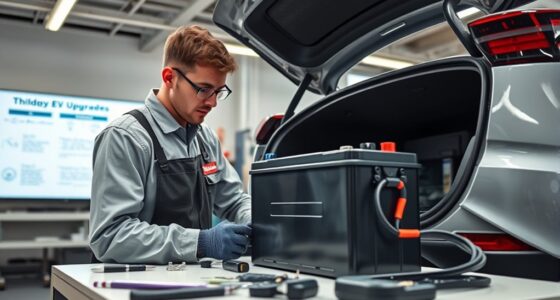Public-private partnerships play a crucial role in advancing battery infrastructure by combining government support with private sector innovation. They help secure funding, develop supply chains for raw materials, and expand charging stations and energy storage. These collaborations reduce risks, accelerate deployment, and foster technological advancements. By working together, governments and private companies can better meet the rising demand for electric vehicles and renewable energy. Keep exploring to find out how these partnerships are shaping a sustainable future.
Key Takeaways
- PPPs combine public resources and private expertise to accelerate battery supply chain development and infrastructure deployment.
- Governments offer incentives, such as tax credits and streamlined permits, to attract private investment in battery projects.
- Collaborations enhance raw material security and stabilize supply chains for critical minerals like lithium and cobalt.
- Public-private efforts drive innovation, research, and faster deployment of EV charging networks and energy storage solutions.
- These partnerships support environmental goals by reducing emissions and promoting sustainable growth through improved battery infrastructure.

Public-private partnerships (PPPs) have become essential in accelerating the development of battery infrastructure, which is critical for supporting the growing adoption of electric vehicles and renewable energy. As you look to expand and improve this infrastructure, understanding how these collaborations work can help you navigate the complex landscape of battery supply and policy incentives. Governments often provide policy incentives to encourage investment in battery manufacturing and infrastructure projects. These incentives might include tax credits, subsidies, or streamlined permitting processes, all designed to reduce financial risks and attract private sector participation. By leveraging these incentives, private companies can secure the funding needed to scale up production and build out charging networks, ensuring that the necessary battery supply is available to meet rising demand.
Public-private partnerships accelerate battery infrastructure by leveraging incentives, reducing risks, and fostering supply chain stability for EV and renewable energy growth.
In a PPP, you’re essentially combining resources and expertise from both the public and private sectors. Governments might offer land, infrastructure support, or favorable policies, while private companies bring technological innovation, operational efficiency, and capital investment. This synergy accelerates the development of battery supply chains, reducing bottlenecks that could hinder growth. For instance, by working together, you can establish strategic partnerships that focus on securing raw materials like lithium, cobalt, and nickel—key components in battery manufacturing. These collaborations help stabilize supply chains, making batteries more affordable and accessible, which in turn encourages more consumers and businesses to switch to electric vehicles and renewable energy solutions.
Policy incentives play a crucial role in shaping the landscape of battery infrastructure development. If you’re involved in a PPP, you’ll want to stay current on government initiatives that support battery production and infrastructure rollout. These policies might include grants for R&D, mandates for renewable energy adoption, or mandates for EV charging stations. By aligning your project with these incentives, you can maximize funding opportunities and minimize costs. Furthermore, policy incentives often foster innovation by encouraging research into advanced battery technologies, which can lead to more efficient, longer-lasting batteries. This ultimately benefits your project by ensuring a reliable battery supply that keeps pace with technological advancements and market demands.
In short, your success in expanding battery infrastructure hinges on effectively harnessing policy incentives and building strategic partnerships that bolster battery supply. Governments are enthusiastic to support these initiatives because they serve broader goals of reducing emissions and fostering sustainable growth. As you navigate this space, remember that collaborations that leverage public incentives and private expertise are your best tools for overcoming supply chain challenges and driving the rapid deployment of electric vehicle charging networks and energy storage solutions.
Frequently Asked Questions
How Do PPP Agreements Ensure Equitable Access to Battery Infrastructure?
PPP agreements guarantee equitable access to battery infrastructure by including community engagement strategies that address diverse needs and prevent disparities. They also rely on strong regulatory frameworks that set clear rules and standards, promoting fairness. You can participate in these partnerships to voice your concerns, helping shape infrastructure projects that serve all communities fairly. This approach fosters transparency and accountability, ensuring that benefits reach everyone, not just select groups.
What Are the Long-Term Financial Benefits for Private Investors?
You’ll find that private investors can see long-term financial benefits, like steady returns from growing battery markets. Tax incentives play a pivotal role, boosting your profit potential, while risk mitigation strategies reduce uncertainties around new technology and market shifts. These benefits encourage sustained investment, helping you capitalize on the expanding demand for clean energy solutions. Ultimately, you gain financially while supporting a sustainable future.
How Do PPPS Address Environmental Sustainability Concerns?
You’ll find that PPPs help address environmental sustainability concerns by promoting renewable integration, ensuring that battery projects support cleaner energy sources. They also emphasize reducing lifecycle emissions through innovative design and efficient operation. By partnering with private entities, you can implement strict environmental standards and monitoring, which collectively minimize ecological impacts and foster sustainable growth in battery infrastructure. This collaboration ultimately benefits both the environment and your long-term energy goals.
What Are Common Challenges Faced During PPP Implementation?
You face several challenges during PPP implementation, with regulatory hurdles being the biggest obstacle—over 60% of projects encounter delays due to complex laws and policies. Funding complexities also pose significant issues, as securing consistent financial support can be difficult amidst changing market conditions. Managing these challenges requires strong coordination, clear policies, and adaptable financial strategies to ensure successful project delivery.
How Is Public Accountability Maintained in Private-Led Projects?
You maintain public accountability in private-led projects by implementing transparency measures, such as clear reporting and open communication channels. Engaging stakeholders regularly ensures their concerns are heard and addressed, fostering trust. You also establish oversight mechanisms like audits and public consultations to keep the private partner answerable. These actions promote transparency, ensure responsible project management, and demonstrate your commitment to serving public interests throughout the project’s lifecycle.
Conclusion
By blending bold business with beneficial public backing, public-private partnerships propel battery infrastructure forward. These dynamic duos deliver decisive development, driving demand and diminishing delays. With mutual momentum and meaningful collaboration, you can cultivate a cleaner, connected, and capable future. Embrace the energy of effective engagement, and you’ll empower progress, promote progress, and propel possibilities. Together, your partnership paves the path for powerful, practical, and protected battery infrastructure.










